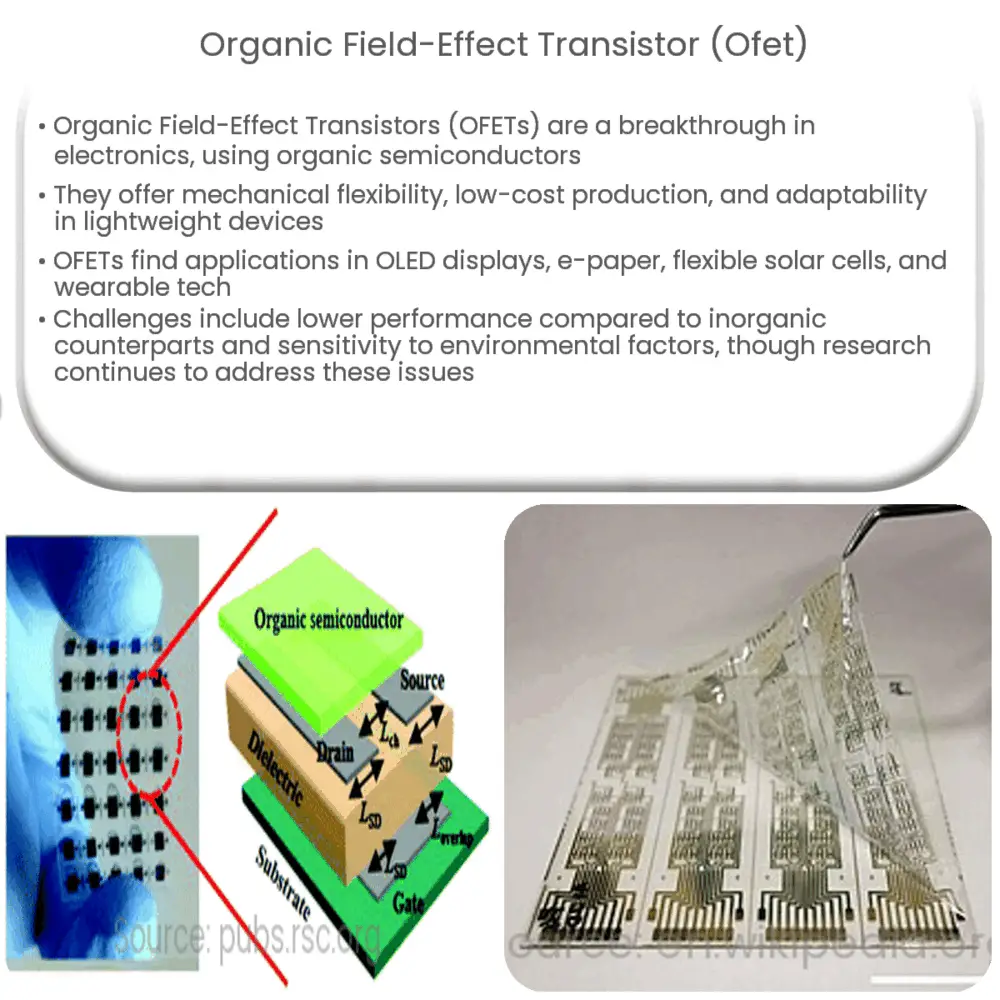Explore the world of Organic Field-Effect Transistors (OFETs): their components, working principle, applications, and future prospects.

Introduction to Organic Field-Effect Transistors (OFETs)
The landscape of electronic devices has been rapidly evolving with the advent of new materials and technologies. Among them, Organic Field-Effect Transistors (OFETs) represent a significant breakthrough in the field of electronics.
OFETs are a type of field-effect transistor that utilize organic semiconductors in their construction. Unlike traditional silicon-based transistors, OFETs offer several unique advantages such as mechanical flexibility, low-cost fabrication, and the ability to be incorporated into lightweight, flexible devices.
Components and Working Principle of OFETs
The key components of an OFET include a source, a drain, a gate, an insulating layer, and an organic semiconductor layer. The operation of an OFET is similar to a traditional transistor, with the primary difference being the use of organic semiconductors. These materials enable the flow of current between the source and the drain, which can be modulated by the voltage applied to the gate.
- Source: This is where the charge carriers, i.e., electrons or holes, originate in the device.
- Drain: This component collects the charge carriers.
- Gate: By applying a voltage to the gate, it’s possible to control the current flow from the source to the drain.
- Insulating Layer: This layer isolates the gate from the organic semiconductor layer.
- Organic Semiconductor Layer: This is the key component of an OFET that distinguishes it from traditional transistors. The organic semiconductor layer allows for the movement of charge carriers.
Types of Organic Semiconductors in OFETs
Organic semiconductors used in OFETs can be primarily divided into two categories: small molecule-based and polymer-based. Small molecule-based semiconductors offer higher mobility, but they require more complex manufacturing processes. On the other hand, polymer-based semiconductors can be processed more easily, making them ideal for large-area applications and flexible electronics.
The choice of organic semiconductor material can greatly influence the properties of the OFET, such as its charge carrier mobility, threshold voltage, and operational stability. These factors are crucial for designing and optimizing OFET-based devices for a range of applications.
Applications of OFETs
Thanks to their unique properties, OFETs find applications in a variety of areas. They are widely used in flexible electronic devices such as organic light-emitting diode (OLED) displays, e-paper, and flexible solar cells. Their low-cost and large-area fabrication potential makes them suitable for printed and wearable electronics.
- Organic Light-Emitting Diode (OLED) Displays: OFETs are commonly used in the fabrication of OLED displays due to their compatibility with organic materials used in the display.
- E-Paper: The flexibility and low-cost fabrication of OFETs make them a great choice for electronic paper technologies.
- Flexible Solar Cells: OFETs can be incorporated into flexible solar cells to increase their efficiency and durability.
- Printed and Wearable Electronics: The potential for OFETs to be printed onto flexible substrates opens up exciting possibilities in the realm of wearable technology, such as smart textiles and health monitoring devices.
Challenges and Future Directions
While OFETs offer promising prospects, there are still some challenges to be addressed. For instance, the performance of OFETs is often lower than their inorganic counterparts due to lower charge carrier mobility. Additionally, the environmental stability of organic semiconductors can be an issue, as they are often sensitive to moisture, oxygen, and heat.
Despite these challenges, ongoing research is being conducted to improve the performance and stability of OFETs. The development of novel organic semiconductor materials and the optimization of device architectures are key areas of focus.
Conclusion
In conclusion, Organic Field-Effect Transistors (OFETs) represent a significant advancement in the field of flexible and low-cost electronics. By leveraging the unique properties of organic semiconductors, OFETs offer a range of possibilities in the development of new electronic devices. While there are still challenges to overcome, the potential of OFETs is enormous, paving the way for future innovations in the realm of electronics.

